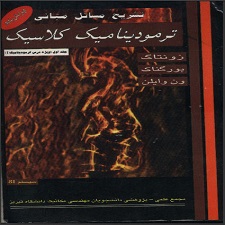توضیحات
ABSTRACT
The oxidation of glycolate to glyoxylate is an important reaction step in photorespiration. Land plants and charophycean green algae oxidize glycolate in the peroxisome using oxygen as a co-factor, whereas chlorophycean green algae use a mitochondrial glycolate dehydrogenase (GDH) with organic co-factors. Previous analyses revealed the existence of a GDH in the mitochondria of Arabidopsis thaliana (AtGDH). In this study, the contribution of AtGDH to photorespiration was characterized. Both RNA abundance and mitochondrial GDH activity were up-regulated under photorespiratory growth conditions. Labelling experiments indicated that glycolate oxidation in mitochondrial extracts is coupled to CO2 release. This effect could be enhanced by adding co-factors for aminotransferases, but is inhibited by the addition of glycine. T-DNA insertion lines for AtGDH show a drastic reduction in mitochondrial GDH activity and CO2 release from glycolate. Furthermore, photorespiration is reduced in these mutant lines compared with the wild type, as revealed by determination of the postillumination CO2 burst and the glycine/serine ratio under photorespiratory growth conditions. The data show that mitochondrial glycolate oxidation contributes to photorespiration in higher plants. This indicates the conservation of chlorophycean photorespiration in streptophytes despite the evolution of leaf-type peroxisomes.
INTRODUCTION
The land plants (Embryophyta) are a monophyletic group that evolved from green algae. The nearest relatives to extant land plants are found within the charophycean green algae (Karol et al., 2001). Both lineages are often subsumed under the term streptophytes based on both cytological and molecular evidence (Lewis and McCourt, 2004). One important feature shared by streptophytes is the presence of leaf-type peroxisomes containing glycolate oxidase (GO) as a key enzyme (Igamberdiev and Lea, 2002). The substrate glycolate is produced in plant and algal chloroplasts from phosphoglycolate, that is itself a primary product of the oxygenase activity of ribulose- 1,5-bisphosphate carboxylase/oxygenase (Rubisco). This activity is a seemingly inevitable but important side reaction of carbon fixation by Rubisco and makes up approximately one-quarter of all Rubisco catalytic events under standard conditions in most higher plants (Sharkey, 2001). The complete process of recycling the products of the oxygenase activity of Rubisco is referred to asphotorespiration (Stabenau and Winkler, 2005; Reumannand Weber, 2006). Streptophytes oxidize glycolate toglyoxylate catalysed by GO in the peroxisomes and concomitantly reduce molecular oxygen to hydrogen peroxide. Glyoxylate is transaminated to glycine in the peroxisome and exported to mitochondria where two molecules of glycine react to form one molecule of serine with the release of CO2 and NH3.
چکیده
اکسیداسیون گلیکولات به گلیوکسیلات یک مرحله واکنش مهم در فتوتراپی است. جلبک های سبز گیاهان و جلبک های دریایی، اکسیده گلیکولات را در پراکسیوم اکسیژن را به عنوان یک فاکتور در اکسید می کنند، در حالیکه جلبک های سبز کلروفیوژن از گلیکولید گلوگزیداز میتوکندری (GDH) با ترکیب عوامل ارگانیک استفاده می کنند. تجزیه و تحلیل های قبلی نشان دهنده وجود GDH در میتوکندری Arabidopsis thaliana (AtGDH). در این مطالعه، اهمیت AtGDH برای فتوتراپی مشخص شده است. هر دو فراوانی RNA و فعالیت های GDH میتوکندری تحت شرایط رشد فتوسپیریتی تنظیم می شوند. آزمایشات برچسب گذاری نشان داد که اکسیداسیون گلیکولات در عصاره های میتوکندری به انتشار CO2 منجر می شود. این اثر می تواند با اضافه کردن عوامل همتراز برای آمینوترانسفرازها، اما توسط افزودن گلیسین مهار می شود. خطوط درج T-DNA برای AtGDH نشان دهنده کاهش شدید فعالیت GDH میتوکندری و انتشار CO2 از گلیکولات است. علاوه بر این، نور خورشید در این خطوط جهش یافته در مقایسه با نوع وحشی کاهش می یابد، که با تعیین میزان انفجار CO 2 و نسبت گلیسین / سریین در شرایط رشد فتوسنتزی نشان داده شده است. داده ها نشان می دهد که اکسیداسیون گلیکولات میتوکندری باعث افزایش فتوتراپی در گیاهان بالاتر می شود. این نشان دهنده حفظ فتوسپیراسیون کلروفیک ایکن در استرپتوفیت ها به رغم تکامل پراکسیزوم های برگ نوع است.
مقدمه
گیاهان زمین (Embryophyta) یک گروه monophyletic هستند که از جلبکهای سبز تشکیل شده است. نزدیکترین بستگان گیاهان خشکی موجود درون جلبک های سبز کوهستانی یافت می شوند (Karol et al.، 2001). هر دو رده، اغلب تحت نام streptophytes بر اساس هر دو شواهد سیتولوژیک و مولکولی (لوئیس و مک کورت، 2004). یک ویژگی مهم که توسط استرپتوفیت ها به اشتراک گذاشته شده، وجود پروکسیزوم های برگ حاوی گلیکولات اکسیداز (GO) به عنوان یک آنزیم کلیدی است (Igamberdiev and Lea، 2002). گلیکولات سوبسترا در کلروپلاست های گیاهی و جلبک از فسفو گلیکوولات تولید می شود که خود محصول اصلی فعالیت اکساگوناز ریوبولوز-1،5-بیس فسفات کربوکسیلاز / اکسیژناز (Rubisco) است. این فعالیت یک واکنش ظاهرا اجتناب ناپذیر، اما مهم از واکنش کربن توسط Rubisco است و تقریبا یک چهارم از همه رویدادهای کاتالیزوری Rubisco را تحت شرایط استاندارد در اکثر گیاهان بالاتر (Sharkey، 2001). فرآیند کامل بازیافت محصولات فعالیت Oxygenase Rubisco به آسپتروپیسیت اشاره دارد (Stabenau و Winkler، 2005؛ Reumannand Weber، 2006). استروپتوفیت ها توالی اکسیدات گلیکولات را به وسیله ی GO به اکسید می کنند و به طور همزمان اکسیژن مولکولی را به پراکسید هیدروژن می رسانند. گلیسيلات به گلیسین در پراکسیوم متصل می شود و به میتوکندری صادر می شود که دو مولکول گلیسین واکنش نشان می دهند تا یک مولکول سریین را با انتشار CO2 و NH3 تشکیل دهند.
Year: 2007
Publisher : Journal of Experimental Botany Advance Access pub
By : Markus Niessen, Krishnaveni Thiruveedhi, Ruben Rosenkranz, Rashad Kebeish, Heinz-Josef Hirsch,Fritz Kreuzaler and Christoph Peterha¨nsel
File Information: English Language/ 7 Page / size: 264 KB
Only site members can download free of charge after registering and adding to the cart
سال : 1386
ناشر : مجله تجربی پیشرفته دسترسی گیاه شناسی
کاری از : Fritz Kreuzaler و Christoph Peterha¨nsel
اطلاعات فایل : زبان انگلیسی / 7 صفحه / حجم : KB 264


![Mitochondrial glycolate oxidation contributes to[taliem.ir]](https://taliem.ir/wp-content/uploads/Mitochondrial-glycolate-oxidation-contributes-totaliem.ir_.jpg)
![Transcriptional Regulation of ROS[taliem.ir]](https://taliem.ir/wp-content/uploads/Transcriptional-Regulation-of-ROStaliem.ir_.jpg)
![PLANT BIODIVERSITY OF HYRCANIAN RELICT FORESTS, N[taliem.ir]](https://taliem.ir/wp-content/uploads/PLANT-BIODIVERSITY-OF-HYRCANIAN-RELICT-FORESTS-Ntaliem.ir_.jpg)

![Effects of Cell Type and Culture Media on Interleukin-6 Secretion[taliem.ir]](https://taliem.ir/wp-content/uploads/Effects-of-Cell-Type-and-Culture-Media-on-Interleukin-6-Secretiontaliem.ir_-1.jpg)
![A performance evaluation model by integrating fuzzy AHP and fuzzy[taliem.ir]](https://taliem.ir/wp-content/uploads/A-performance-evaluation-model-by-integrating-fuzzy-AHP-and-fuzzytaliem.ir_-150x150.jpg)
![Evolution and mechanisms of plant tolerance to flooding stress[taliem.ir]](https://taliem.ir/wp-content/uploads/Evolution-and-mechanisms-of-plant-tolerance-to-flooding-stresstaliem.ir_-1-150x150.jpg)
نقد و بررسیها
هنوز بررسیای ثبت نشده است.